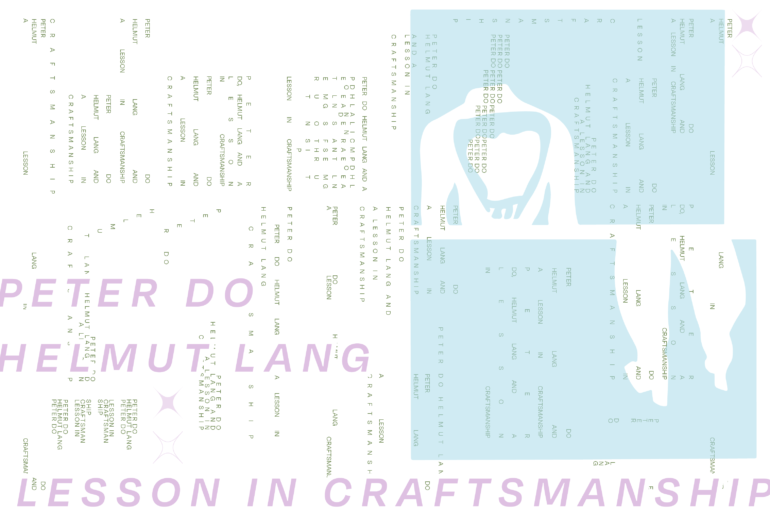There’s a case to be studied about anonymity in the creative world. The anonymous are able to revel in the face of contained public opinion and behind plausible deniability, where the depth of that perception is both their only mirror and sole identifier. If it’s not for the opportunity to allow art to speak for itself, what is the point of being known as an artist in anonymity at all?
“Artist” is the most distinctive characteristic here. I’m not talking about a sinister past uncovered in a series of screenshots in a Twitter thread or the cost of racial ambiguity when using an alias. The anonymity in question is entirely specific, and all thanks to a backless two piece suit. Peter Do is not known by face, but by design. Even now, with only a backlit photo giving light (see also: shadow) to his physical form, his clothes speak more life to his name than a selfie ever could.
My first impression of him begins and ends with NCT’s Jeno opening Do’s spring 2023 collection show during New York Fashion Week. He was dressed in a rendition of a smoking tuxedo jacket and wide slacks with equally wide slits on the side, towering over the runway with chunky platform heels. The front was nice enough to look at, but the tailoring of the suit’s rotated teardrop cut out stole the show and cemented Do on my list of fashion designers who I’d hire out of pure delusion. His minimalist design is signature and undeniably recognizable.
Do’s collection often features a series of structured silhouettes that swing like a pendulum between masculine and feminine. Though the garments were restricted to black, white, and cream, it’s impossible to be disheartened by the lack of color. The strict theme was an accent to highlight the true detailing that sets Do’s designs apart: craftsmanship.
Where Do situates himself as a master of his aesthetic is the care built in each garment. It’s simple and sleek, meant to be paired and worn in more ways than one. Simplicity is too understated a term to describe Do. His capabilities go beyond making fashion design seem easy. His minimalism makes the very complexity people search for in clothing look effortless.
Ready-to-wear requires attention to detail and the market, though it’s not the same conversation where re-wearability is concerned. Do designs for the chronic outfit repeater who idealizes and yearns for versatility in a one-size-fits-all-styles type of way. Both parties pay no mind to outfit rememberers in the slightest. A fit is a fit, regardless of how many times it is worn or mixed or matched. To wear a garment infinitely falls onto the shoulders of craftsmanship. The longevity of its design is held by the strength of seams, and more than that, intent.
Do catered to this dynamic when he dropped 20 pieces that complete his FW23 collection titled MODULAR in a digital reveal on Vogue. Each piece contributes to a year’s worth of styling, with 365 looks being curated. There’s whispers that this collection is shaping the brand to be known for its quiet luxury, but what those labels mistake for anti-embellishments is actually pro-sustainability. There are pieces that originate from Do’s older works, proving an explicit emphasis on re-use rather than recycling.
Prior to MODULAR’s drop, Peter Do’s future as the helm of his brand raised questions after news of his position as Helmut Lang’s new creative director was announced. His first collection with Hemlut Lang is set to debut as part of New York Fashion Week this September. And now that we’ve ridden the waves of the aftermath, his supporters can rest assured that Do’s capabilities are more than enough to carry the creative brunt of both brands.
Lang left his fashion house to pursue other art forms in life. Of the creative directors that took over in his absence, few were able to replicate the refined personality brought into the brand’s older version of minimalism. In Do’s case, he cited Lang as an inspiration during his formative design years as a student at the Fashion Institute of Technology. It’s not the act of looking up to someone as the basis for success. Do’s clear qualifications for the role is reflected within his existing portfolio. People wear Peter Do to mimic the high-end feeling of Hemlut Lang, like an adrenaline junkie seeking comfort in a specific high that can only be sought by an alternative. An energy like this exists in Do’s vision, without the worry of what more he could possibly save for his own brand and what parts of himself would need to translate into Helmut Lang.
There’s no sacrifice to be made in terms of creativity. If anything, Do’s direction brings forth the influencing power of his touch on craftsmanship, re-wearability, and dynamic minimalism. Helmut Lang couldn’t have been left in better hands.
Words by Bri Shufford.
Graphic by Fai McCurdy.

